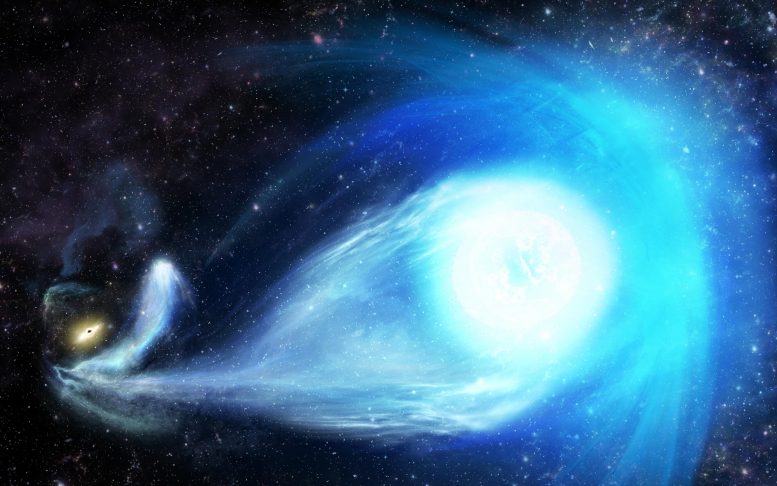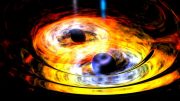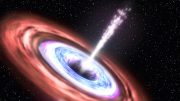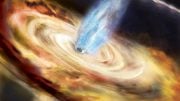
An artist’s impression of the Milky Way’s big black hole flinging the star from the galaxy’s center. Credit: James Josephides (Swinburne Astronomy Productions)
An international study has discovered a star traveling at more than six million km/h through the Milky Way after being flung from the center of our galaxy by a supermassive black hole.
The eviction occurred about five million years ago, around the time when our ancestors were just learning to walk upright.
Emeritus Professor Gary Da Costa, an astronomer at The Australian National University (ANU), said the star is moving so fast that it will leave the Milky Way in about 100 million years, never to return.
“We traced this star’s journey back to the center of our galaxy, which is pretty exciting,” said Professor Da Costa from the ANU Research School of Astronomy and Astrophysics.
“This star is traveling at record-breaking speed — 10 times faster than most stars in the Milky Way, including our Sun.
“In astronomical terms, the star will be leaving our galaxy fairly soon and it will likely travel through the emptiness of intergalactic space for eternity. It’s great to be able to confirm a 30-year-old prediction that stars can be flung out of a galaxy by the supermassive black hole at its center.”
The giant black hole at the center of the Milky Way, Sagittarius A*, has a mass equivalent to more than four million Suns.
Professor Da Costa and his ANU colleagues Dr. Dougal Mackey and Dr. Thomas Nordlander were involved with the study, which was led by Dr. Sergey Koposov from Carnegie Mellon University as part of the Southern Stellar Streams Spectroscopic Survey.
An artist’s impression of the ejection mechanism of a star by a supermassive black hole. Credit: James Josephides (Swinburne Astronomy Productions)
The survey involves astronomers from Australian universities including ANU, Macquarie University, the University of Sydney, and UNSW, as well as researchers from the US, UK, and Chile. Dr. Ting Li from the Carnegie Observatories and Princeton University leads the survey.
Dr. Mackey said the team spotted the fast-moving star serendipitously while searching for the shredded remains of small galaxies orbiting the Milky Way.
“The star is only 29,000 light-years away, quite close by galactic standards, which means the team could measure its trajectory very precisely,” Dr. Mackey said.
Dr. Nordlander said supermassive black holes can slingshot stars by interacting with a binary stellar system, whereby two stars orbit around each other.
“If such a binary system approaches a black hole too closely, the black hole can capture one of the stars into a close orbit and kick out the other at very high speed.”
The team made the discovery of the star using the 3.9-meter (12.8-foot) Anglo-Australian Telescope at the ANU Siding Spring Observatory. The facility’s 2dF instrument is the best in the world for studying the sparsely distributed stars in the outskirts of the Milky Way, due to its ability to obtain simultaneous measurements for up to 400 targets at a time.
Follow-up observations made with the ANU 2.3-meter (7.5-foot) telescope played an important role in confirming the star’s extreme speed.
The results of the study are published in the Monthly Notices of the Royal Astronomical Society.
Read Star Ejected by Supermassive Black Hole at Heart of Milky Way for more on this discovery.
Reference: “Discovery of a nearby 1700 km/s star ejected from the Milky Way by Sgr A*” by Sergey E Koposov, Boubert Douglas, S Li Ting, Denis Erkal, Gary S Da Costa, Daniel B Zucker, Alexander P Ji, Kyler Kuehn, Geraint F Lewis and Dougal Mackey, 4 November 2019, Monthly Notices of the Royal Astronomical Society.
DOI: 10.1093/mnras/stz3081









Chandaryaan2 new record https://www.sarthtya.tech/2019/11/chandaryaan2-chandaryaan2-new-record.html?m=1
when she says she’s home alone
ain’t that 5 times the speed of light?
impossibru imho
Na yulian light travels nearly 3,000,000 Kmp second, this star is traveling 6m kp hour
Wait my numbers were wrong lol its 300,000 mps, but still the star is traveling 1/3 the speed of light thats crazy fast